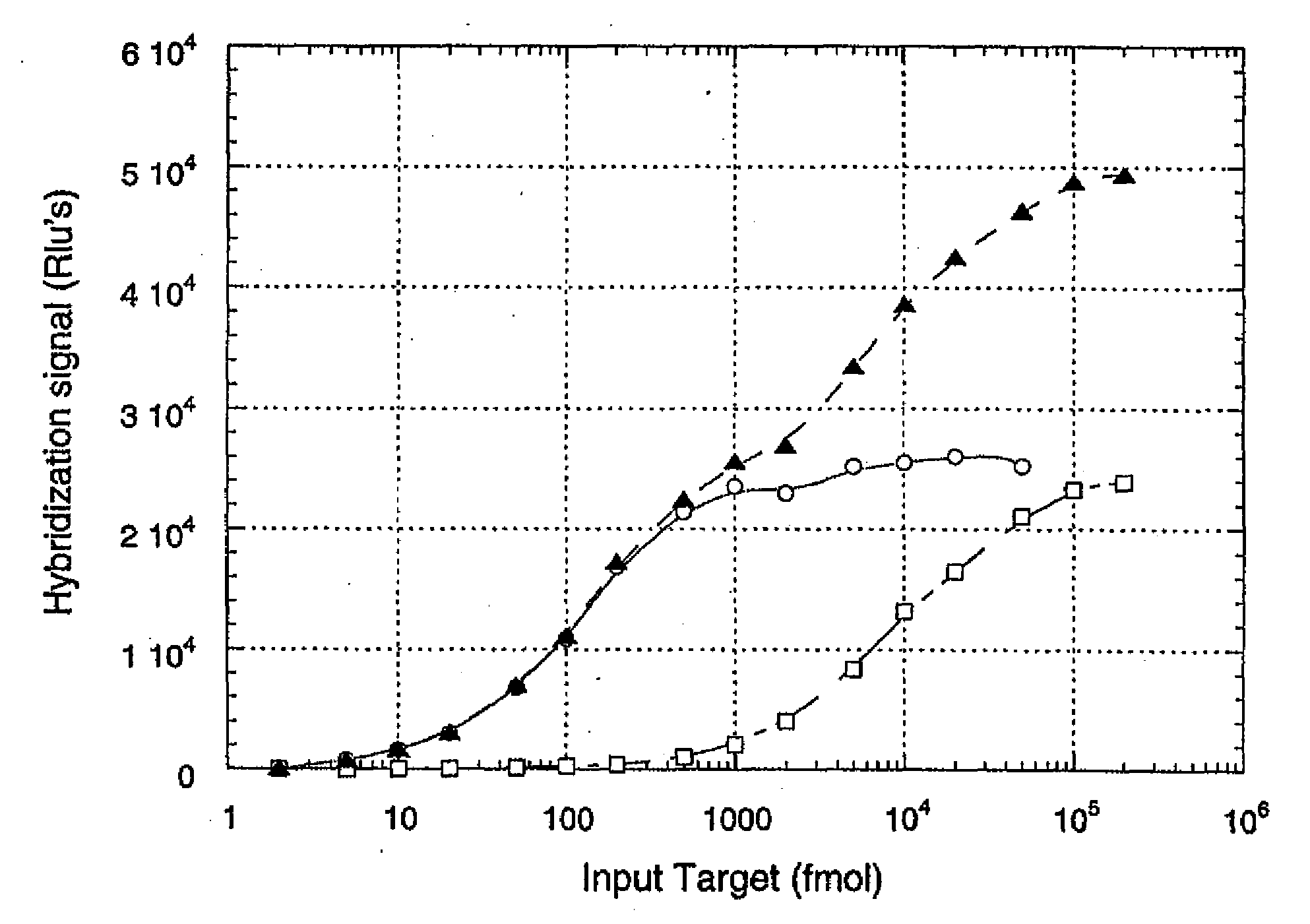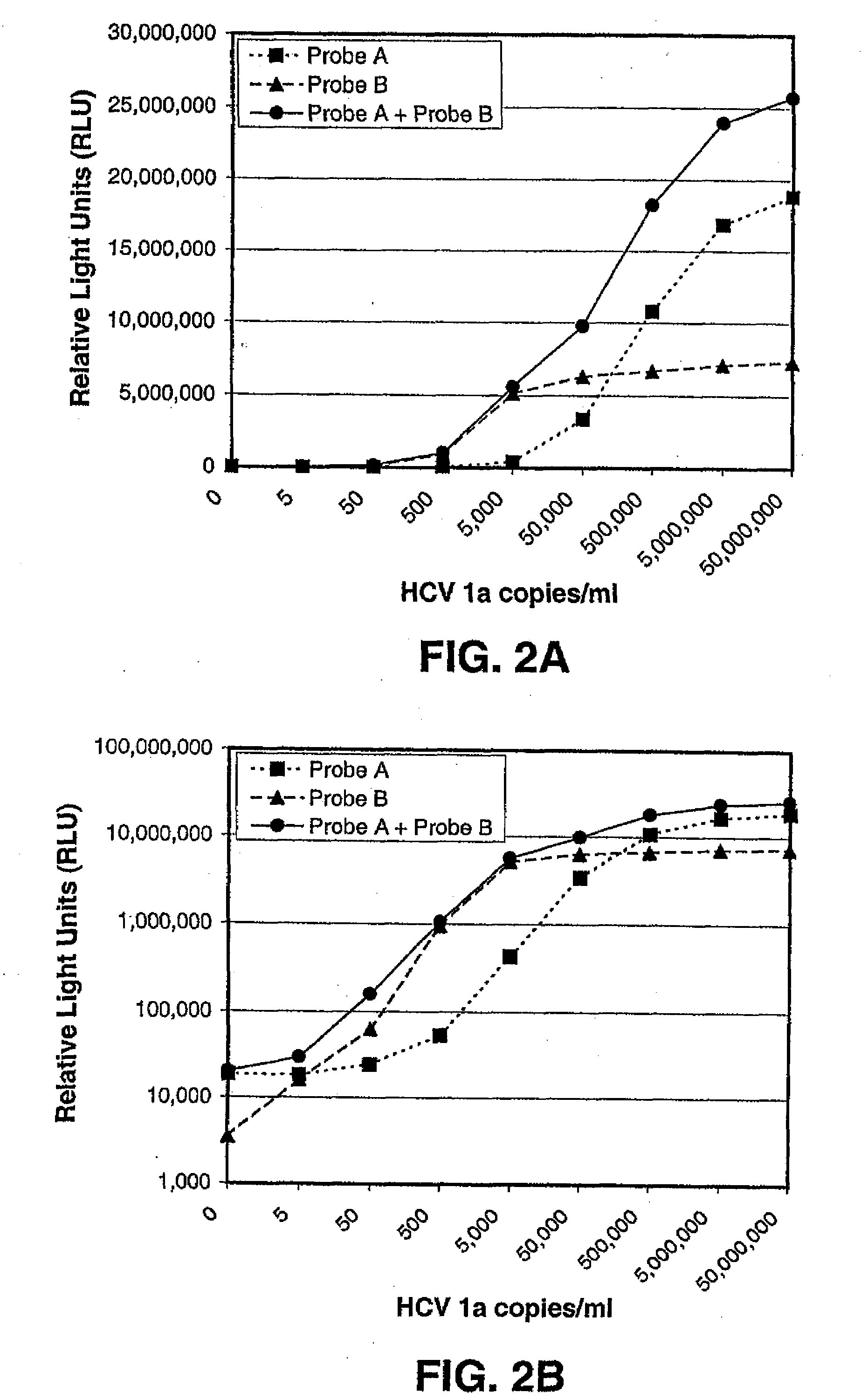Affinity-shifted probes for quantifying analyte polynucleotides
- Summary
- Abstract
- Description
- Claims
- Application Information
AI Technical Summary
Benefits of technology
Problems solved by technology
Method used
Image
Examples
example 1
Extending the Dynamic Range of a Quantitative Assay Using a Plurality of Labeled Probes Having Detectable Labels that are Indistinguishable
[0134]To demonstrate the basis of the quantitative approach underlying the present invention, an experiment was conducted using three types of hybridization reaction, each reaction being characterized by its own dynamic range. Target RNA, representing a model polynucleotide in the procedure, had the sequence AUGUUGGGUUAAGUCCCGCAACGAGC (SEQ ID NO:1). A first probe was a synthetic 26-mer DNA molecule having the sequence GCTCGTTGCGGGACTTAACCCAACAT (SEQ ID NO:2), and was labeled with acridinium ester (AE) to a specific activity of 1.31×108 rlu / pmole. The second probe was a synthetic 20-mer DNA molecule having the sequence TGCGGGACTTAACCCAACAT (SEQ ID NO:3), and was labeled with AE to a specific activity of 9.37×107 rlu / pmole. The first and second probes were labeled with AE moieties between positions 16 and 17, and between positions 10 and 11, respec...
example 2
Quantitation of HCV Using Nucleic Acid Amplification and an Extended Dynamic Range Hybridization Assay
[0140]An HCV-1a ARMORED RNA (Ambion, Inc.; Austin, Tex.) that included HCV genomic sequences served as the template nucleic acid that was amplified in this procedure. ARMORED RNA® technology is used for producing ribonuclease-resistant RNA controls and standards by assembling specific RNA sequences and viral coat proteins into pseudo-viral particles. The template nucleic acid underwent specimen processing and target capture essentially according to the procedures disclosed in published International Patent Application No. PCT / US2000 / 18685, except that the template was captured using HCV-specific oligonucleotides rather than HIV-specific oligonucleotides. These procedures were conducted using 500 μl aliquots of stock samples having concentrations of HCV templates that ranged from 5 copies / ml up to 5×107 copies / ml. An HCV pseudo target that contained sequences corresponding to amplifi...
example 3
Molecular Beacons Having Different Affinities for a Single Target Polynucleotide Exhibit Differential Binding at Different Target Concentrations
[0148]Molecular beacon probes having the sequences of SEQ ID NOs:4-8 were independently synthesized by solid-phase phosphite triester chemistry using 3′ DABCYL-linked controlled pore glass and 5′ fluorescein-labeled phosphoramidite on a Perkin-Elmer (Foster City, Calif.) EXPEDITE model 8909 automated synthesizer. All of the molecular beacons were constructed using 2′-methoxy nucleotide analogs. Biotin moieties were introduced into the loop portions of the molecular beacon sequences (as indicated in FIG. 5) using biotin phosphoramidite purchased from Glen Research Corporation (Sterling, Va.). Following synthesis, the probes were deprotected and cleaved from the solid support matrix by treatment with concentrated ammonium hydroxide (30%) for two hours at 60° C. Next, the probes were purified using polyacrylamide gel electrophoresis followed by...
PUM
| Property | Measurement | Unit |
|---|---|---|
| Substance count | aaaaa | aaaaa |
| Substance count | aaaaa | aaaaa |
| Substance count | aaaaa | aaaaa |
Abstract
Description
Claims
Application Information
 Login to View More
Login to View More - R&D
- Intellectual Property
- Life Sciences
- Materials
- Tech Scout
- Unparalleled Data Quality
- Higher Quality Content
- 60% Fewer Hallucinations
Browse by: Latest US Patents, China's latest patents, Technical Efficacy Thesaurus, Application Domain, Technology Topic, Popular Technical Reports.
© 2025 PatSnap. All rights reserved.Legal|Privacy policy|Modern Slavery Act Transparency Statement|Sitemap|About US| Contact US: help@patsnap.com



